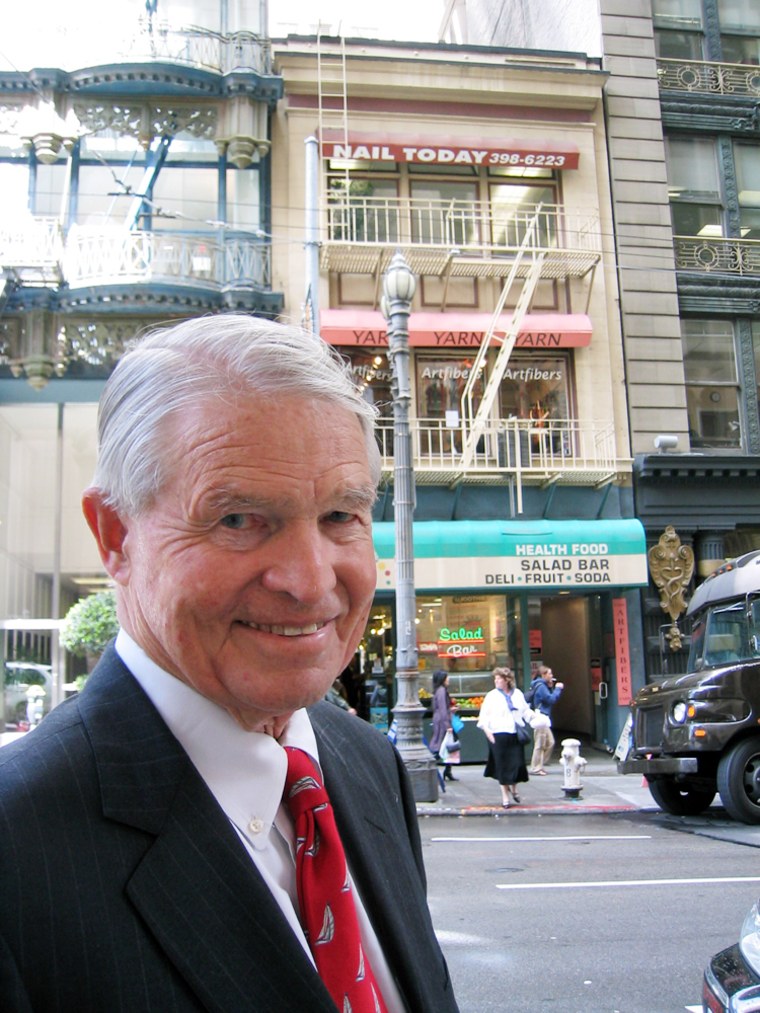SAN FRANCISCO — As Winston Churchill once said, “A pessimist sees the difficulty in every opportunity; an optimist sees the opportunity in every difficulty.”
Among the optimists after the 1906 earthquake that devastated the city were a college dropout named Colbert Coldwell and a traveling salesman named Benjamin Banker.
Seeing promise where many others only saw pandemonium, the young men's drive led to the creation of one of the most venerated names in American real estate: Coldwell Banker.
Opportunity out of disaster
“It was leveled — there was nothing left!” exclaimed Bill Banker, the son of Benjamin Banker, as he strolled down Sutter Street in downtown San Francisco. “A few buildings stood but the typical streets were just rubble.”
Banker, an energetic 84-year-old, was relating the story told to him by his father of the scene of destruction in San Francisco after the estimated 7.8 magnitude earthquake stuck the city on April 18 a hundred years ago.
The massive quake struck at 5:12 am while most San Franciscans were still in bed. An estimated 6,000 people were killed and more than half of the city’s 400,000 residents were left homeless.
“My father ... came to San Francisco just after the earthquake as a meat slicing machine salesman from Illinois, working for a Chicago meat packing company,” recalled Banker. “He said the city was utterly a mess. With all the hotels gone, he had to sleep in an old boarding house. And to top it all off, most of the city’s butcher shops were destroyed, so he was left with little business.”
But while looking for some new ways of making a living, Banker stumbled upon a part-time job selling lots in an area of San Francisco called Visitacion Valley.
“You didn’t need a real estate license at that time,” said his son. “And father sold four lots on his first day. Father was hooked and he quit his job as a salesman for good.”
Instead, Banker took a job with a real estate company called W.B. McGeary. And that's where fate played its hand — the firm was located in the same building where a young 23-year old U.C.-Berkeley dropout had also set up shop as a real estate broker.
His name was Colbert Coldwell.
Introducing ethics to real estate
Coldwell, in fact, had got into the real estate business earlier than Banker, having established the firm Tucker, Lynch and Coldwell immediately after the quake with the goal of introducing what was a new concept in the real estate business at the time: ethics. The new firm was “based on the principles of honesty, integrity and service,” according to Coldwell Banker’s Web site. However, Coldwell's first partners fairly soon left the firm, leading to the partnership, formed in 1913, that was to transform the real estate business.
“What people don’t realize was that during the quake, most of the public records were destroyed in the fire,” said Bill Banker. “You had no idea who owned what. So unscrupulous brokers would put up false ‘For Sale’ signs on a pile of rubble and tried to profit from the sale of properties that weren’t theirs to sell.”
Coldwell emphasized that no one in his company could personally profit from the sale of a property. (In fact, up until the early 1970s, no Coldwell Banker broker could own personal property other than his own home.) “They gave the buyer the benefit of all profit and represented the seller for a commission only,” said Bill Banker.
Modest beginning
The three-story brick building the partners moved to by 1920 still stands today at 128 Sutter Street in downtown San Francisco, dwarfed by modern skyscrapers.
The ground floor where young Coldwell and Banker nourished their fledgling firm is now occupied by a deli. The second floor is a yarn shop and the top floor is a nail salon. When the owners of the deli were asked if they knew about the building’s historical past, they just smiled and shrugged.
“Unfortunately, most people don’t know much about how father and Coldwell started the firm,” said Banker. “The earthquake sort of brought them together because there was such a dynamic growth taking place rebuilding this city.”
Bill Banker, himself a Coldwell Banker employee from 1946 to 1973, still looks with awe at the building.
“This is sort of fun to see this little building which is 20 feet wide and 60 feet deep and see where it all started,” he said.
Out of ashes
Today, Coldwell Banker has 126,000 sales associates in 4,000 offices across 30 countries and territories with sales in 2004 totaling $325.9 billion.
Benjamin Banker died in 1965 at 80. Coldwell died two years later, at 84, having never retired from Coldwell Banker.
“I don’t think my father had any idea how this company would pick itself up from the ashes and grow so big,” said Bill Banker wistfully as he took another look at 128 Sutter Street.
“Not in a million years.”
